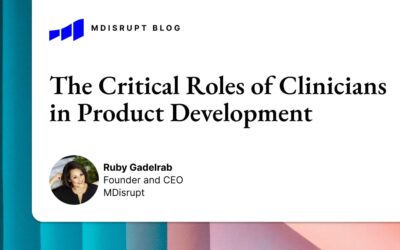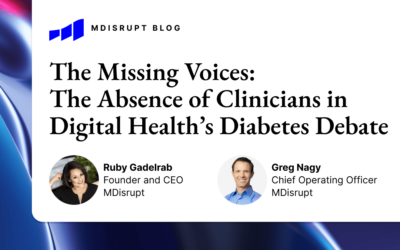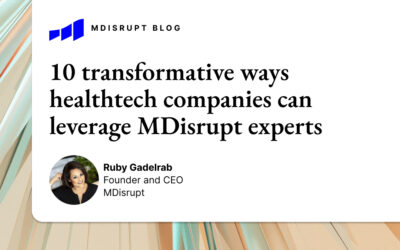
Meet Chet Robson, DO, chief clinical officer at Walgreens.

Beginning as a family practice physician, Robson went on to C-suite positions at health systems and one of the largest health retailers. He was an early adopter of electronic medical records (EMR), educating himself and helping colleagues understand how to use and implement them. He later earned his MBA at Dartmouth in health care delivery science with a focus on how healthcare can be delivered to different populations. At Walgreens, he delivers healthcare directly to the consumer on a national scale—in everyone’s neighborhood.
Listen to the full interview here.
MDisrupt: How do you envision healthcare delivery in the US changing?
Chet Robson: Health care is becoming more home- and consumer-driven. Examples of this include telemedicine for care delivery, oral oncology medications that can be taken at home, home testing (COVID-19 testing, cholesterol and genetic tests), mental health coaching, and health tracking through apps. Hospitals are having to become parts of a system that reach beyond the hospital walls; integrating with retail pharmacies, companies like Uber, and more.
From the pharmacy standpoint, it’s a very similar theme—meeting consumers where they live and making it easy for them to get medications and other health care services. Several retail healthcare venues now have primary care doctors’ offices inside of their pharmacies—an elegant integration of delivery models supplementing the norms of the traditional health care system.
The final piece is the payment models to help facilitate care. It’s not simply about how we pay for a particular diagnosis and treatment , but how we pay for the prevention, the treatment, and the aftercare for the best outcome.
Recently with COVID-19, there’s been a huge evolution of home delivery, medication, and medical goods.
MDisrupt: As a health retailer, how do you evaluate innovative technology for introduction into the retail pharmacy market?
Chet Robson: This is always an exciting challenge because there are so many great ideas at different stages of development. Given this, we have a very formalized approach that we go through. The first thing we evaluate when a company brings something new to us is identifying what problem the technology is trying to solve. We’ve seen things where it’s great technology and an interesting scientific venture, but it doesn’t really solve a problem. Then we dive into the fundamentals around the basic medical science, clinical efficacy, real-world evidence data, multi-population studies, outcomes, and feedback that affects patients around use, price, insurance coverage, and ordering. We really want to understand if the technology actually improves the problem that needs improving.
From a business standpoint, we evaluate if there is a sustainable business model and synergistic fit with our current strategy. There are many times we’ll see products that are really very good, interesting, but it might not really be the exact right fit for what our current strategy is or what we’re trying to achieve.
MDisrupt: Adverse drug reactions are the fourth leading cause of death in the US, but pharmacogenomics is still not a standard of care. How do we reconcile that and where is it going?
Chet Robson: I share that frustration with you because I’m a big believer in pharmacogenomics. It could really become a valuable tool, but we are still along the pathway to integrating it into the standard model of care. First, it’s “newer” science to the general public, regulatory bodies, and legal organizations so there are hurdles around education and defining how to use the information in patient care. Second, we have to become very specific about the benefits, impact, and use cases for pharmacogenomics. Third, there are operational challenges around getting the information into a prescriber’s workflow so that the health care provider, at the point of writing the prescription, has access to drug interaction information. It has to be simple and straightforward. Lastly, the information has to be available to anyone who’s going to interact with it. This includes the healthcare provider and the pharmacist, so they can support each other to ensure that drug interactions are identified and acted on appropriately.
MDisrupt: Do you have an example of a country or health system that’s been successful in implementing a PGx program?
Chet Robson: We’ve implemented a very successful program through Walgreens Boots Alliance and our independent pharmacies in the Netherlands. The health system in the Netherlands is a single payer system, so both the physician and the pharmacists have access to a common EMR. This is critical because the physician or pharmacist can look up a patient’s drug interaction information. The physician can request a pharmacogenomics test, the patient’s results get added to the system, the pharmacist sees the results, and then walks the patient through the information. If there’s an actionable medication, the pharmacist can then connect with the physician to request a change of medication. It’s worked extremely well and we’ve had really good uptake. Even throughout the pandemic we’ve seen the number of pharmacogenomics tests going up greatly because there is a good deal of interest from the patients. The other interesting piece is that the physicians look at the pharmacies now as part of the whole ecosystem. It’s still early and we’ve not even completed a year, but the initial results have been strong.
MDisrupt: What’s the future for pharmacogenomics?
Chet Robson: PGx is beginning to be a part of a bigger picture of understanding a robust genetic overview of an individual. Currently we have an understanding of phenotype through biometric testing, lab testing, and imaging, but we tend not to have a very good genetic view. To be able to fully manage a patient’s health, you have to understand that entire equation including the social determinants of health.
The FDA a year or so ago really pulled back on the pharmacogenomics information that could be released to patients. Currently, they’ve begun to make major strides moving forward by looking much more deeply at the research and working with the Clinical Pharmacogenetics Implementation Consortium (CPIC) and other organizations. A major hurdle to overcome is the FDA becoming more comfortable with what PGx offers. Payors are also doing a lot of different testing in various different forms with pharmacy benefit managers (PBMs), sometimes with their insured populations, and sometimes with particular disease states.
As you begin to make PGx an actionable, value-based test, we’re going to need to become much more refined in our risk stratification of how we use the test. It’s an important piece of the total comprehensive view of the patient.
MDisrupt: What does the pharmacy of the future look like?
Chet Robson: There’s only about four ways to manage health and disease. First, maintain health by exercise and good nutrition. The second is to prevent illness through immunizations, routine testing, continuous health monitoring. Third is medication delivery and education. And fourth are interventions like surgery and radiation. Pharmacists can play an integral role in the first three ways by providing medication and treatment expertise.
Part of the pharmacy of the future is helping pharmacists become integrated in delivering health services rather than simply delivering prescriptions. This can include mail or home delivery, telemedicine, followup care, and clinical services. Pharmacies are already in everybody’s neighborhood and it creates a network of places where people can easily access the health resources they need. Lastly, in the virtual world of health apps tied to medication and health management, digital pharmacy services can play an important part in medication management, providing immunization information, or answering questions around the clock via Ask A Pharmacist chat. Having that virtual, always-ready connection is definitely going to play a critical role in the pharmacy of the future.
The pharmacy of the future is really an expansion of what we do now. It’s about allowing the pharmacist to use their full skills rather than just operational ones, thus allowing people to connect virtually and in-person to their local pharmacy. It’s about an interconnected healthcare ecosystem that meets people where they live and experience health care. A health care system that operates in the continuum of people’s lives—living, working, and virtually.
At MDisrupt we believe the most impactful health products should make it to market quickly. We connect digital health innovators to the healthcare industry experts and scientists they need to responsibly accelerate product development, commercialization, adoption, and scale.
If you are building a pharmacogenomics or other health product, MDisrupt can help. Talk to us.



